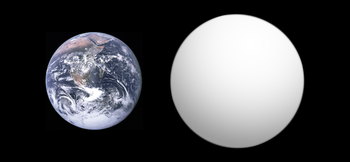Bumi super

Bumi super adolah planet lua surya jo massa lebiah gadang dari Bumi, tapi jauah di bawah raksasa es Tata Surya ajak Uranus dan Neptunus, nan masiang-masiang punyo 14,5 dan 17 kali massa Bumi.[1] Istilah "Bumi super" hanyo mangacu pado massa gadangnyo planet, dan indak tasirek apo pun tantang kondisi parmukoan atau kelaikhunian. Istilah alternatif "katai gas" mungkin labiah akurat untuak inyo nan barado di ujuang skala massa nan labiah tinggi, bilo " Neptunus mini" iyolah istilah nan labiah umum.
Definisi
[suntiang | suntiang sumber]Sacaro umum, Bumi super ditantuan dek massanyo, dan istilah iko indak manjalehan suhu, komposisi, sifaik orbit, kalaikhunian, atau lingkuangan alam. Samantaro babarapo sumber umumnyo satuju jo bateh atas iyolah 10 kali massa Bumi[1][2][3] (~69% dari massa Uranus, nan marupoan planet raksasa Tata Surya jo massa taketek) dan batas bawah bavariasi dari 1 [1] atau 1,9 [3] hinggo 5 kali massa Bumi[2] baikuti dek babagai definisi lain nan tabik di media populer.[4][5][6] Istilah "Bumi super" paguno juo dek para astronom untuak marujuak pado planet nan labiah gadang dari planet sarupo Bumi (dari 0,8 hinggo 1,2 kali jari-jari Bumi), tapi labiah ketek dari Neptunus mini (dari 2 hinggo 4 kali jari-jari Bumi).[7][8] Definisi iko dibuek dek operator teleskop lua angkaso Kepler.[9] Babarapo panulis labiah lanjuik manyarankan dek istilah Bumi super mungkin tabateh pado planet babatu tanpa atmosfer nan signifikan, atau planet nan indak hanyo punyo atmosfer tapi jua punyo parmukoan padek atau lautan jo bateh nan tajam antaro caiaran dan atmosfer, nan indak dipunyo dek kaampek planet raksasa Tata Surya.[10] Planet di ateh 10 kali massa Bumi disabuik planet padat masif,[11] mega-Bumi,[12][13] atau planet raksasa gas,[14] tagantuang pado apakah inyo tadiri ateh sabagian gadang batu dan es atau sabagian gadang gas.
Caliak pulo
[suntiang | suntiang sumber] Media tantang Bumi super di Wikimedia Commons
Media tantang Bumi super di Wikimedia Commons- Bumi
Rujuakan
[suntiang | suntiang sumber]- ↑ a b c Valencia, V.; Sasselov, D. D.; O'Connell, R. J. (2007). "Radius and structure models of the first super-earth planet". The Astrophysical Journal. 656 (1): 545–551. arXiv:astro-ph/0610122
 . Bibcode:2007ApJ...656..545V. doi:10.1086/509800.
. Bibcode:2007ApJ...656..545V. doi:10.1086/509800.
- ↑ a b Fortney, J. J.; Marley, M. S.; Barnes, J. W. (2007). "Planetary Radii across Five Orders of Magnitude in Mass and Stellar Insolation: Application to Transits". The Astrophysical Journal. 659 (2): 1661–1672. arXiv:astro-ph/0612671
 . Bibcode:2007ApJ...659.1661F. doi:10.1086/512120.
. Bibcode:2007ApJ...659.1661F. doi:10.1086/512120.
- ↑ a b Charbonneau, D.; et al. (2009). "A super-Earth transiting a nearby low-mass star". Nature. 462 (7275): 891–894. arXiv:0912.3229
 . Bibcode:2009Natur.462..891C. doi:10.1038/nature08679. PMID 20016595.
. Bibcode:2009Natur.462..891C. doi:10.1038/nature08679. PMID 20016595.
- ↑ Spotts, P. N. (28 April 2007). "Canada's orbiting telescope tracks mystery 'super Earth'". The Hamilton Spectator. Diarsipkan dari versi asli tanggal 2015-11-06.
- ↑ "Life could survive longer on a super-Earth". New Scientist (2629). 11 November 2007.
- ↑ "A team of ICE/IEEC astronomers announces the discovery of a possible terrestrial-type exoplanet orbiting a star in the constellation of Leo". Institut de Ciències de l'Espai. 10 April 2008. Diarsipkan dari versi asli tanggal 1 March 2012. Diakses tanggal 2012-04-28.
- ↑ Fressin, François; et al. (2013). "The false positive rate of Kepler and the occurrence of planets". Astrophysical Journal. 766 (2): 81. arXiv:1301.0842
 . Bibcode:2013ApJ...766...81F. doi:10.1088/0004-637X/766/2/81.
. Bibcode:2013ApJ...766...81F. doi:10.1088/0004-637X/766/2/81.
- ↑ Fulton, Benjamin J.; et al. (2017). "The California-Kepler Survey. III. A Gap in the Radius Distribution of Small Planets". The Astronomical Journal. 154 (3): 109. arXiv:1703.10375
 . Bibcode:2017AJ....154..109F. doi:10.3847/1538-3881/aa80eb.
. Bibcode:2017AJ....154..109F. doi:10.3847/1538-3881/aa80eb.
- ↑ Borucki, William J.; et al. (2011). "Characteristics of planetary candidates observed by Kepler, II: Analysis of the first four months of data". The Astrophysical Journal. 736 (1): 19. arXiv:1102.0541
 . Bibcode:2011ApJ...736...19B. doi:10.1088/0004-637X/736/1/19.
. Bibcode:2011ApJ...736...19B. doi:10.1088/0004-637X/736/1/19.
- ↑ Seager, S.; Kuchner, M.; Hier-Majumder, C. A.; Militzer, B. (2007). "Mass–radius relationships for solid exoplanets". The Astrophysical Journal. 669 (2): 1279–1297. arXiv:0707.2895
 . Bibcode:2007ApJ...669.1279S. doi:10.1086/521346.
. Bibcode:2007ApJ...669.1279S. doi:10.1086/521346.
- ↑ Seager, S. (2007). "Mass‐Radius Relationships for Solid Exoplanets". The Astrophysical Journal. 669 (2): 1279–1297. arXiv:0707.2895
 . Bibcode:2007ApJ...669.1279S. doi:10.1086/521346.
. Bibcode:2007ApJ...669.1279S. doi:10.1086/521346.
- ↑ Astronomers find a new type of planet: The 'mega-Earth'
- ↑ Dimitar Sasselov (2 June 2014). "Exoplanets: From Exhilarating to Exasperating, 22:59, Kepler-10c: The 'Mega-Earth'". YouTube
- ↑ Mayor, M.; Pepe, F.; Lovis, C.; Oueloz, D.; Udry, S. (2008). "The quest for very low-mass planets". di dalam Livio, M.. A Decade of Extrasolar Planets around Normal Stars. Cambridge University Press. ISBN 978-0521897846.
